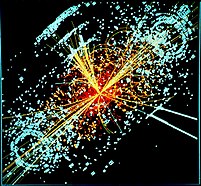 Image via Wikipedia
Image via Wikipedia
The Standard Model
On Wednesday, the European Organization for Nuclear Research will inject high energy beams of particles into the Large Hadron Collider(LHC). Located underground on the French-Swiss border, the CERN facility is the most advanced particle research laboratory on the planet.
Physicists hope their experiments using the LHC will help them fill in missing pieces of the Standard Model, which currently requires the assumption of certain as-yet unobserved particles and processes. In particular, the long sought-after Higgs Bosun should become apparent (artist’s conception pictured at right). Finding proof for its existence is crucial to the current understanding of our universe. The Standard Model just doesn’t work without it.
Simply put, the Higgs Bosun is required if anything in the universe is to have mass. Without it, nothing would have mass. Without mass, no galaxies, no stars, no planets, no us. It’s easy to see why it’s been called the ‘God Particle’. Without it, or something that takes its place, nothing that does exist could exist. At least, according to our current understanding of the universe.
Should You Worry?
If you google LHC or CERN right now you should have no problem finding numerous blogs and articles predicting end-of-the-world scenarios as the result of the planned experiments. It seems everybody who took a physics class in high school has an opinion on the matter. Many of their fears revolve around the idea that a black hole will be created, which will swallow the earth. Looking around the CERN website, I came across these two quotes. You can click them to read them in their original context:
Though black holes seem to capture most folks’ attention, there are some other side-effects that have been addressed. For instance, the creation of things like cosmic rays, magnetic monopoles, strangelets and vacuum bubbles could prove to be interesting, if they occur. They sure make for some interesting reading, in any case. But the likelihood that any of these things could be a danger to the earth or any regular guy or girl on the street is practically zero.
Watch It Live Online
As can be expected of the most advanced physics lab on the planet, they’re making much use of the internet. Part of that includes the CERN Webcast Service, with 4 channels of video. Check it out for the schedule of live events. I watched a bit of it – it reminded me of NASA TV, which is pretty cool, when you think about it.
NASA deals with the infinite universe around us, and CERN deals with the infinitely small universe that makes us. NASA has opened us up to wonders we never expected but secretly dreamed of. Like the ice on Mars, the volcanos on Io, the galaxies of the earliest universe. CERN’s LHC project may introduce us to fantastic breakthroughs of the same magnitude.
Imagine finding extra dimensions of space, particles of dark matter, or just watching a recreation of the conditions in the universe, less than a second after it was created. These are some of the things more than 1000 scientists are hoping for.
But it most likely won’t happen Wednesday. All these things, the hopeful and the fearful, depend on collisions of the particles. The first collisions are scheduled to occur in October. Wednesday claims its fame by being the first day they will direct a beam around the circumference of the collider. (So even if the world is going to end because of this thing, it won’t happen Wednesday.)
The Experiments
There are six main experiments the LHC is designed to perform. Each of them are international collaborations, bringing together scientists from institutes all over the world. Each experiment focuses on answers to questions about the Higgs bosun, looking for extra dimensions, or why only about 4% of the universe is made of matter, to name a few. (which makes the rest… what?)
Over the next several weeks I’ll publish some pieces getting into more detail with each of these experiments. We’ll see why the collider had to be built mostly underground, why it had to be so large, and why what these guys are doing is so important. So, until then…
I am Jon, and I’m just a little bit hyped.
UPDATE 10 SEP 2008: The LHC Goes Live – 1st Beam A Success. Click the link to read the press release.



The safety opposition alleges CERN is misrepresenting the certainty of safety and did not properly address[9] opposition arguments by credible senior scientists including visiting professor of Physics Dr. Otto Rössler[1][2] and Physics PHD Dr. Rainer Plaga[3].
Planetary safety arguments include disputed cosmic ray arguments[1][2][3] and refuted Hawking Radiation[4][5].
Earlier in 2008 CERN acknowledged that if micro black holes were created[6] by head-on collissions in particle colliders some would travel too slowly to escape Earth while cosmic ray created stable micro black holes would not be stopped by Earth.[7] This safety argument flaw was as discovered by former Cosmic Ray Researcher, California Math Champion and Nuclear Safety Officer Walter L. Wagner.[8]
[1] http://www.wissensnavigator.com/documnets/OTTOROESSLERMINIBLACKHOLE.pdf Abraham-Solution to Schwarzschild Metric Implies That CERN Miniblack Holes Pose a Planetary Risk, Prof. Dr. Otto Rossler (2008)
[2] http://www.wissensnavigator.com/documents/spiritualottoeroessler.pdf A Rational and Moral and Spiritual Dilemma – Otto E. Rössler Safety Counter Arguments (2008)
[3] http://www.arxiv.org/PS_cache/arxiv/pdf/0808/0808.1415v1.pdf On the potential catastrophic risk from metastable quantum-black holes produced at particle colliders – Rainer Plaga Rebuttal (2008)
[4] http://www.xxx.lanl.gov/abs/gr-qc/0304042 Do black holes radiate?. Dr. Adam Helfer (2003)
[5] http://www.arxiv.org/abs/gr-qc/0607137, On the existence of black hole evaporationyet again, Prof. VA Belinski (2006)
[6] http://www.cerncourier.com/cws/article/cern/29199 The case for mini black holes, CERN Courier (2004)
[7] http://www.lhcconcerns.com/LHCConcerns/Forums/phpBB3/viewtopic.php?f=2&t=2&st=0&sk=t&sd=a&start=10 LHC Safety Assessment Group, LHC Safety Procedures, 16 Mar 2008
[8] http://www.lhcdefense.org/lhc_legal.php US Federal Lawsuit Filings – Walter L. Wagner (2008)
[9] http://www.ingentaconnect.com/content/bpl/risk/2006/00000026/00000001/art00006 Scientific Peer Review to Inform Regulatory Decision Making: A European Perspective (2006)
Thanks for stopping by JTankers. I’ve edited your comment to make all your links live, in case anybody wants to click and go there to see for themselves. You included some great links there. I’ve read some of them already and I’ll check out the ones I haven’t read yet. Thanks for the roadsigns.
I agree, there is still some uncertainty about what will happen with micro black holes possibly produced with the LHC. I’ll be covering some of that in upcoming posts about the individual experiments planned to start in October.
In any case, this week we should have nothing to fear, as no collisions are planned until those first experiments are performed next month.
Meanwhile, I’d like to recommend JTankers site for those with a greater curiosity about the LHC. There are lots of links and some really good write-ups about many of the concerns scientists have about CERN’s most ambitious project.